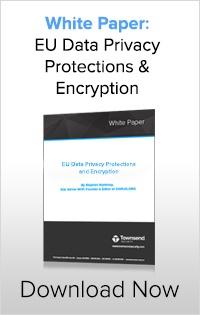Here is a sneak peek at the introduction for the latest regulatory guidance white paper from Townsend Security. For detailed information, download the entire document:

On March 25, 2014, the Article 29 Data Protection Working Party of the European Union issued new guidance on data breach notification and the use of data protection technologies such as encryption and encryption key management. Extending beyond just Internet Service Providers, the new regulations cover all organizations that process, store, or transmit private information of EU citizens. Along with these new regulations, there are substantial financial penalties for failing to protect sensitive information. These penalties can reach into the 10’s of millions of Euros depending on the organization’s size and amount of data compromised.
The European Union does not mandate that all organizations immediately encrypt sensitive data, but the only exclusion for subject data breach notification and financial penalties will be for those organizations who use encryption and other security methods to protect the data. Applying these security methods after a breach will not remove the notification requirements and penalties.
EU Data Protection Directive (also known as Directive 95/46/EC) is a directive adopted by the European Union designed to protect the privacy and protection of all personal data collected for or about citizens of the EU, especially as it relates to processing, using, or exchanging such data. The following guidelines will help meet these new EU objectives:
Encrypt Data at Rest
Make a full inventory of all sensitive personal information that you collect and store. Use strong encryption to protect this data on servers, PCs, laptops, tablets, mobile devices, and on backups. Personal data should always be encrypted as it flows through your systems, and when you transmit it to outside organizations.
Use Industry Standard Encryption
Use industry standard encryption such as Advanced Encryption Standard (AES, also known as Rijndael). AES is recognized world-wide as the leading standard for data encryption. Never use home-grown or non-standard encryption algorithms.
Use Strong Encryption Keys
Always use cryptographically secure 128-bit and 256- bit AES encryption keys and never use passwords as encryption keys or the basis for creating encryption keys. Encryption keys based on passwords will never meet minimum standards for strong encryption keys. Keys should be generated using a cryptographically secure random bit generator (CS-RBG) validated to international standards.
Protect Encryption Keys from Loss
Encryption keys must be stored away from the data they protect and must be securely managed. Manual procedures cannot accomplish the goal of proper encryption key management. Use a professional encryption key management solution to protect keys and provide different keys for different data protection needs. Key management solutions should implement key creation, management, and distribution and be compliant with the NIST FIPS 140-2 standard recognized and accepted worldwide.
Change Encryption Keys Regularly
Using one encryption key for a long period of time can expose you to a breach notification for historical data. Change your encryption keys on a quarterly or semi-annual basis. A good key management solution can automatically change encryption keys at an interval you define.
Use Strong, Industry Standard Hash Algorithms
Use strong, industry standard secure hash algorithms when protecting passwords and other information. Never use MD5 or other weaker hash methods. Use the SHA-256 or SHA-512 methods for your hash requirements.
Use Keys or Salt with Your Hashes
When using a strong secure hash algorithm, always use an encryption key or random salt to strengthen the resulting hash value. You can use the Hashed Message Authentication Code (HMAC) method with an encryption key or use a strong encryption key under the protection of a key manager as the salt for the hash method.

